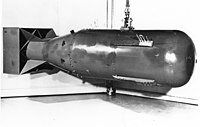
Photo from wikipedia
The Arctic has warmed more than twice as fast as the global average since the late twentieth century, a phenomenon known as Arctic amplification (AA). Recently, there have been considerable… Click to show full abstract
The Arctic has warmed more than twice as fast as the global average since the late twentieth century, a phenomenon known as Arctic amplification (AA). Recently, there have been considerable advances in understanding the physical contributions to AA, and progress has been made in understanding the mechanisms that link it to midlatitude weather variability. Observational studies overwhelmingly support that AA is contributing to winter continental cooling. Although some model experiments support the observational evidence, most modelling results show little connection between AA and severe midlatitude weather or suggest the export of excess heating from the Arctic to lower latitudes. Divergent conclusions between model and observational studies, and even intramodel studies, continue to obfuscate a clear understanding of how AA is influencing midlatitude weather. Amplified warming in the Arctic has been linked to weather variability in the midlatitudes. This Review considers the evidence from both observations and modelling studies on this link for increasing severe winter weather, including cold temperatures and heavy snowfalls.
Journal Title: Nature Climate Change
Year Published: 2019
Link to full text (if available)
Share on Social Media: Sign Up to like & get
recommendations!